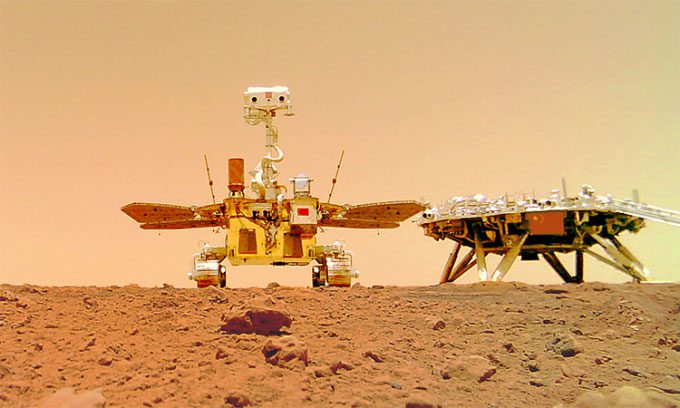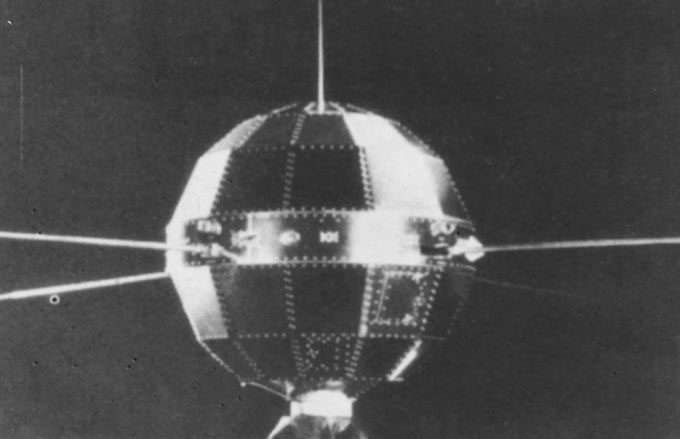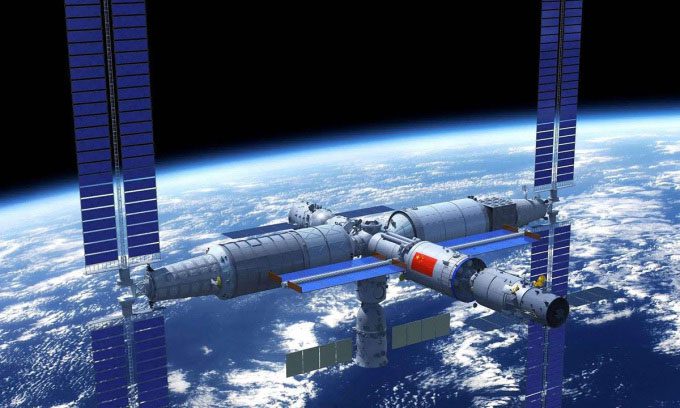Once absent from the “playground” of space exploration, China is now one of the few countries capable of sending humans into space and launching spacecraft to other planets.
In 1957, the Soviet Union shocked the world by successfully launching the first artificial satellite into space, Sputnik 1. At that time, the late Chinese President Mao Zedong reportedly lamented that China couldn’t even send a potato into space. During that era, China was completely absent from the realm of space exploration.

China’s Zhurong rover and landing station on Mars. (Photo: CNSA).
In 2023, after more than six decades of pursuing the “space dream”, China astounded the world by not only successfully launching numerous satellites, building its own space station, and sending humans into Earth orbit but also landing robots on celestial bodies such as the Moon and Mars. Today, China is an indispensable name when discussing global space powers.
The Development of China’s Space Program
In 1957, Mao Zedong announced that China would also launch its own satellite. With the support of Soviet technology and scientists like Qian Xuesen, who studied and worked in the United States, the country developed an ambitious space program.
The first significant milestone occurred in 1970 when China launched its first artificial satellite, Dong Fang Hong 1, from the Jiuquan Satellite Launch Center in Gansu Province. Although it lacked complex technology, this satellite made China the fifth nation to put a satellite into orbit after the Soviet Union, the United States, France, and Japan.
Excited by the success of Dong Fang Hong 1, China announced plans to send two astronauts into space in 1973 under the Project 714, officially approved in 1971. However, the project was canceled due to political instability at the time.

Dong Fang Hong 1 satellite. (Photo: Xinhua).
By the 1980s, China began launching satellites regularly and entered the commercial market, providing satellite launch services to other countries and companies at competitive prices.
In 1992, China announced Project 921 aimed at launching a crewed spacecraft into space and returning to Earth. This goal was achieved in 2003, making China the third country after the United States and the Soviet Union to use its own rocket to send humans into space. Astronaut Yang Liwei completed a spaceflight lasting about 21 hours aboard Shenzhou 5.
In the following years, as China’s economy rapidly grew, the government began to invest heavily in its space program. According to SCMP, spending on spacecraft research and development rose from $22.6 million in 2000 to $433.4 million in 2014.
Over the past decade, China has consistently achieved significant successes that have garnered global attention. In 2013, the Yutu rover from the Chang’e 3 mission landed on the Moon, becoming the first Chinese rover to do so and the first rover in the world to land on the Moon in nearly four decades. In 2018, China launched Chang’e 4, carrying the Yutu 2 rover. By 2019, Yutu 2 successfully landed on the Moon’s far side, making China the first country in history to achieve this feat.
The year 2020 marked several significant milestones in China’s space exploration efforts. In December, the Chang’e 5 mission successfully landed on the Moon and returned rock samples to Earth. This was the first time in 44 years that lunar samples were successfully brought back (the previous sample return was from the Soviet Luna-24 mission in 1976). In July, China launched Tianwen-1, its first spacecraft to travel to another planet. The spacecraft landed on Mars in May 2021, making China the second country to achieve this, after the United States.
In 2022, China completed Tiangong, the space station that began development in 2011. The space station currently consists of three modules operated by rotating crews of three astronauts. When the International Space Station (ISS) ceases operations, expected in 2030, Tiangong may become the only space station in orbit dedicated to scientific research.

Simulation of the Tiangong space station in orbit around Earth. (Photo: CMSEO)
China’s Future Space Exploration Plans
One of China’s most notable space projects is to send humans to the Moon before the end of 2030. “The project will also aim for short-term habitation on the lunar surface, sample collection, and research”, stated Lin Xiqiang, deputy director of the China Manned Space Agency, following the launch of the Shenzhou 16 crewed spacecraft in May this year.
Another significant project is the collaboration with Russia to build a lunar base. According to Assistant Professor Svetla Ben-Itzhak at Air University (Alabama, USA), the International Lunar Research Station (ILRS) will be located at or near the Moon’s south pole. Crewed missions, both long-term and short-term, related to the base are expected to be implemented in the early 2030s.
“Some of China’s goals include lunar exploration to study the potential for exploiting energy and materials on the Moon, training humans to leave Earth, establishing long-term research stations, developing products and industries in outer space, and creating a self-sustaining extraterrestrial environment”, Ben-Itzhak told the Indian Express.
Other future missions include expanding the Tiangong space station, launching additional spacecraft to Mars, and planning launches to Jupiter and Saturn.
The Impact of China’s Space Program on the World
China’s spectacular space achievements actually benefit all of humanity, remarked Dumitru Prunariu, Romania’s first and only astronaut to travel into space, at the Asia’s Century international conference held in July 2022.
In 2021, China spent up to $16 billion on its space program, second only to the United States, which had a budget of $60 billion, an impressive figure. Meanwhile, India is among the top seven countries spending the most on space. “The regional security dynamics and China’s new capabilities in space could encourage India to advance further in developing its own space capabilities”, Ben-Itzhak shared with the Indian Express.
As the International Space Station (ISS) prepares for “retirement” in the coming years, Tiangong could become the only operational space station. It is projected that the Tiangong station will host over 1,000 scientific experiments during its operational period, including an international project between the CMSA and the United Nations Office for Outer Space Affairs (UNOOSA). The China National Space Administration (CNSA) has shown readiness for international collaboration and will allow non-Chinese astronauts to participate in future missions aboard the station. In addition to welcoming foreign astronauts, the station may even open its doors to tourists by the end of this decade.
China is also collaborating with Russia to build the ILRS – a human base on the Moon. The CNSA and Russia’s Roscosmos have invited other countries to join the program. If successful, the ILRS will mark a significant milestone in humanity’s quest to conquer other celestial bodies.


















































